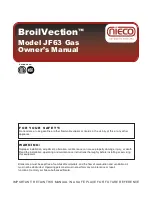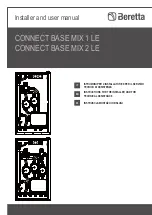
Tft Series Installation and Operation Instructions
│
Trinity
55
Low Voltage Connections
Like the line voltage, the low voltage wiring connections to the Trinity Tft are made at the junction box in the
control panel located at the bottom of the boiler cabinet. The connections are accessed by removing the front
door of the boiler, followed by the removal of the control panel cover. Field connections are to be installed in
accordance with Figure 12-2 and Tables 12-2a and 12-2b. Holes are located on the bottom (underside) of the
control panel junction box.
Fuse (24VAC)
- Trinity Tft models are equipped with a “blade style” 2 Amp fuse to
protect the internal transformer located within the control panel box.
Table 12-2 (a) Low Voltage Field Connections (Communication and Sensor I/O)
Connection
Location
Description
C
OM
M.
DATA +
1
Lead-Lag
–
Terminals 1, 2 and 3 can be "daisy-chained" to multiple boilers (up to 8 in
total) for the purpose of staging. For lone boiler applications, these terminals can be
alternatively used for communication to an external device (i.e. Building Automation
System, BAS)
DATA -
2
DATA COM
3
4-20mA (+)
4
External Modulation Control
– Using a 4-20mA signal connected to terminals 4 and 5,
an external control can be used to directly modulate the burner firing rate or adjust the
active set point. This can be useful for applications using external staging controls or
Building Automation Systems.
4-20mA (-)
5
SENSO
R
COM
6
Sensor Common
–
Common port for field inputs SYSTEM, OUTDOOR and DHW.
SYSTEM
7
System Water Temperature
–
An optional strap-on System Sensor is available from
NTI (P/N 84010). When connected to terminals 6 and 7, the control will indicate a “CH”
or “Lead-Lag” temperature. Sensor can be used for direct modulation of system
temperature.
OUTDOOR
8
Outdoor Temperature Sensor
–
A wall mountable OD Sensor is included with each
boiler. When connected to terminals 6 and 8, the control will indicate the outdoor
temperature and Outdoor Reset function will be operable.
DHW
9
DHW Tank Demand
–
Input requiring closure of terminals 6 and 9 to initiate a demand
for DHW. Switch made via isolated end switch (dry contact) from a thermostat
(aquastat) located in an Indirect Fired Water Heater. Or optional DHW Tank Sensor
(NTI P/N 84632), see Appendix A for details.
Table 12-2 (b) Low Voltage Field Connections (24VAC I/O)
Connection
Location
Description
COM
(24VAC)
1
24VAC Common
– Neutral for the 24VAC power supply from the boiler. COM can be
used in conjunction with terminal R to provide a power source for a digital thermostat.
R
(24VAC)
2
24VAC Hot
- Power supply for inputs LIM, CH1 and CH2 (LL).
3
LIM
4
External Limit
– Input requiring 24VAC from terminal R to permit the burner to operate.
Comes factory equipped with a jumper to the R terminal. For installations requiring the
use of an additional safety switch, such as a Flow Switch, or auxiliary temperature limit,
remove the factory installed jumper and install the normally open isolated contacts of the
additional limit in its place.
CH1
5
Local Central Heat Demand
– Input requiring 24VAC from terminal R to initiate a
“local” CH call. Switch is made using an isolated end switch (dry contact) via thermostat,
zone controller or other device. Typically used as the lone heat input or as the high
temperature input in dual CH temperature systems.
CH2 (LL)
6
Lead-Lag Central Heat Demand
–
Input requiring 24VAC from terminal R to initiate a
“lead-lag” CH call. Switch is made using an isolated end switch (dry contact) via
thermostat, zone controller or other device. Typically used as a lead-lag input for cascaded
boilers or as the low temperature input in dual CH temperature systems.
ALARM
7
Normally Open Alarm Contacts
– Contacts close during a lockout or other alarm
condition. May be connected to a BMS, maximum capacity of 0.63Amps at 24VAC.
8
















































